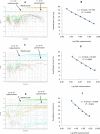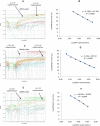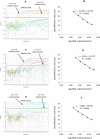One-step multiplex real-time RT-PCR assay for detecting and genotyping wild-type group A rotavirus strains and vaccine strains (Rotarix® and RotaTeq®) in stool samples
- PMID: 26839745
- PMCID: PMC4734446
- DOI: 10.7717/peerj.1560
One-step multiplex real-time RT-PCR assay for detecting and genotyping wild-type group A rotavirus strains and vaccine strains (Rotarix® and RotaTeq®) in stool samples
Abstract
Background. Group A rotavirus (RVA) infection is the major cause of acute gastroenteritis (AGE) in young children worldwide. Introduction of two live-attenuated rotavirus vaccines, RotaTeq® and Rotarix®, has dramatically reduced RVA associated AGE and mortality in developed as well as in many developing countries. High-throughput methods are needed to genotype rotavirus wild-type strains and to identify vaccine strains in stool samples. Quantitative RT-PCR assays (qRT-PCR) offer several advantages including increased sensitivity, higher throughput, and faster turnaround time. Methods. In this study, a one-step multiplex qRT-PCR assay was developed to detect and genotype wild-type strains and vaccine (Rotarix® and RotaTeq®) rotavirus strains along with an internal processing control (Xeno or MS2 RNA). Real-time RT-PCR assays were designed for VP7 (G1, G2, G3, G4, G9, G12) and VP4 (P[4], P[6] and P[8]) genotypes. The multiplex qRT-PCR assay also included previously published NSP3 qRT-PCR for rotavirus detection and Rotarix® NSP2 and RotaTeq® VP6 qRT-PCRs for detection of Rotarix® and RotaTeq® vaccine strains respectively. The multiplex qRT-PCR assay was validated using 853 sequence confirmed stool samples and 24 lab cultured strains of different rotavirus genotypes. By using thermostable rTth polymerase enzyme, dsRNA denaturation, reverse transcription (RT) and amplification (PCR) steps were performed in single tube by uninterrupted thermocycling profile to reduce chances of sample cross contamination and for rapid generation of results. For quantification, standard curves were generated using dsRNA transcripts derived from RVA gene segments. Results. The VP7 qRT-PCRs exhibited 98.8-100% sensitivity, 99.7-100% specificity, 85-95% efficiency and a limit of detection of 4-60 copies per singleplex reaction. The VP7 qRT-PCRs exhibited 81-92% efficiency and limit of detection of 150-600 copies in multiplex reactions. The VP4 qRT-PCRs exhibited 98.8-100% sensitivity, 100% specificity, 86-89% efficiency and a limit of detection of 12-400 copies per singleplex reactions. The VP4 qRT-PCRs exhibited 82-90% efficiency and limit of detection of 120-4000 copies in multiplex reaction. Discussion. The one-step multiplex qRT-PCR assay will facilitate high-throughput rotavirus genotype characterization for monitoring circulating rotavirus wild-type strains causing rotavirus infections, determining the frequency of Rotarix® and RotaTeq® vaccine strains and vaccine-derived reassortants associated with AGE, and help to identify novel rotavirus strains derived by reassortment between vaccine and wild-type strains.
Keywords: Gastroenteritis; Multiplex qRT-PCR; RotaTeq®; Rotarix®; Rotavirus genotyping.
Conflict of interest statement
The authors declare that they have no competing interests.
Figures






Similar articles
-
Real-time RT-PCR assays to differentiate wild-type group A rotavirus strains from Rotarix(®) and RotaTeq(®) vaccine strains in stool samples.Hum Vaccin Immunother. 2014;10(3):767-77. doi: 10.4161/hv.27388. Epub 2013 Dec 16. Hum Vaccin Immunother. 2014. PMID: 24342877 Free PMC article.
-
Rotavirus.Clin Lab Med. 2015 Jun;35(2):363-91. doi: 10.1016/j.cll.2015.02.012. Clin Lab Med. 2015. PMID: 26004648 Review.
-
Detection and genotyping of human rotavirus VP4 and VP7 genes by reverse transcriptase PCR and reverse hybridization.J Clin Microbiol. 2009 Sep;47(9):2704-12. doi: 10.1128/JCM.00378-09. Epub 2009 Jun 24. J Clin Microbiol. 2009. PMID: 19553575 Free PMC article.
-
Differentiation of RotaTeq® vaccine strains from wild-type strains using NSP3 gene in reverse transcription polymerase chain reaction assay.J Virol Methods. 2016 Nov;237:72-78. doi: 10.1016/j.jviromet.2016.08.022. Epub 2016 Aug 30. J Virol Methods. 2016. PMID: 27590978
-
Genetic diversity of G1P[8] rotavirus VP7 and VP8* antigens in Finland over a 20-year period: No evidence for selection pressure by universal mass vaccination with RotaTeq® vaccine.Infect Genet Evol. 2013 Oct;19:51-8. doi: 10.1016/j.meegid.2013.06.026. Epub 2013 Jul 4. Infect Genet Evol. 2013. PMID: 23831933 Review.
Cited by
-
Coding-complete genome sequences of rotavirus A reference strains EDIM, Ph158, and CC425.Microbiol Resour Announc. 2023 Nov 16;12(11):e0063023. doi: 10.1128/MRA.00630-23. Epub 2023 Oct 12. Microbiol Resour Announc. 2023. PMID: 37823654 Free PMC article.
-
Development and evaluation of a one-step multiplex real-time TaqMan® RT-qPCR assay for the detection and genotyping of equine G3 and G14 rotaviruses in fecal samples.Virol J. 2019 Apr 25;16(1):49. doi: 10.1186/s12985-019-1149-1. Virol J. 2019. PMID: 31023319 Free PMC article.
-
Diversity of rotavirus strains circulating in Haiti before and after introduction of monovalent vaccine.IJID Reg. 2022 Jul 14;4:146-151. doi: 10.1016/j.ijregi.2022.07.007. eCollection 2022 Sep. IJID Reg. 2022. PMID: 35923644 Free PMC article.
-
Acute Infectious Gastroenteritis: The Causative Agents, Omics-Based Detection of Antigens and Novel Biomarkers.Children (Basel). 2021 Dec 2;8(12):1112. doi: 10.3390/children8121112. Children (Basel). 2021. PMID: 34943308 Free PMC article. Review.
-
Development of a Real-Time Reverse Transcription-PCR Assay To Detect and Quantify Group A Rotavirus Equine-Like G3 Strains.J Clin Microbiol. 2021 Oct 19;59(11):e0260220. doi: 10.1128/JCM.02602-20. Epub 2021 Aug 25. J Clin Microbiol. 2021. PMID: 34432486 Free PMC article.
References
-
- Banyai K, Laszlo B, Duque J, Steele AD, Nelson EA, Gentsch JR, Parashar UD. Systematic review of regional and temporal trends in global rotavirus strain diversity in the pre rotavirus vaccine era: insights for understanding the impact of rotavirus vaccination programs. Vaccine. 2012;30(Suppl 1):A122–130. doi: 10.1016/j.vaccine.2011.09.111. - DOI - PubMed
-
- Boom JA, Sahni LC, Payne DC, Gautam R, Lyde F, Mijatovic-Rustempasic S, Bowen MD, Tate JE, Rench MA, Gentsch JR, Parashar UD, Baker CJ. Symptomatic infection and detection of vaccine and vaccine-reassortant rotavirus strains in 5 children: a case series. Journal of Infectious Diseases. 2012;206(8):1275–1279. doi: 10.1093/infdis/jis490. - DOI - PMC - PubMed
LinkOut - more resources
Full Text Sources
Other Literature Sources
Miscellaneous

